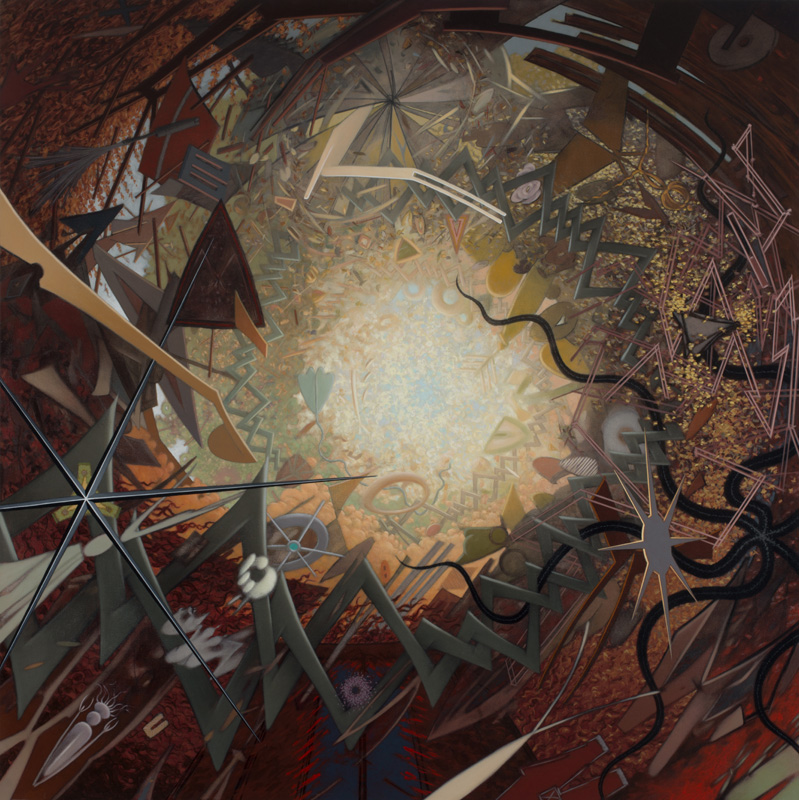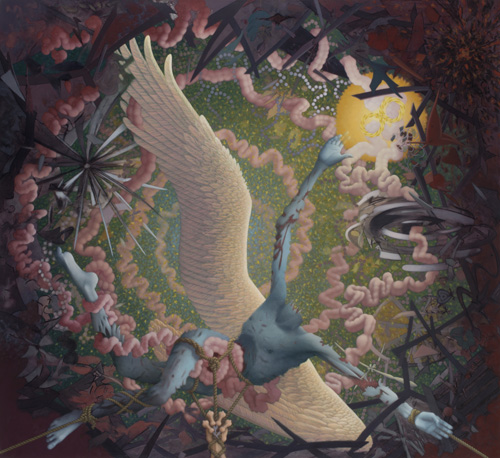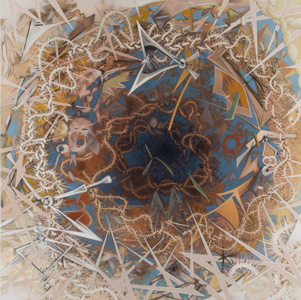
 |
| Dark Vortex 1985, acrylic on canvas 66 x 66 in. |
Dark Vortex |
The Dark Vortex is one of only a few seminal pieces in my art. It was created at the end of over 12 years of abstract painting and thereby represents a culmination of the ideas I explored during that period. At the same time it marks the beginning of a transitional period that links my abstract work to my newer representational work. The significance of the Dark Vortex can be seen in my first use of a center-focused composition and of a transcendent "window or portal" space, both of which foretell their use in future work. In addition, it was my first use of the circle/spiral/vortex compositional form as a life-cycle symbol, a symbol that carries spiritual and philosophical implications. Throughout my abstract period I pursued the ideas of change and transformation. To that end I developed a language of forms that are amorphous, lacking specific identities, and exist on the edge of recognizability – forms that embody change and transformation. I placed them in spaces that are often fractured, creating a disjointed world full of movement – a chaotic world in flux. As the abstract period developed the identities of the individual forms became more distinct, the spaces more cohesive, and the world more organized. In the Dark Vortex these characteristics reached a pinnacle where the forms, the spaces, and the world became unified. Another important aspect of the Dark Vortex is its relationship to the viewer. Through the use of a vortex composition it was my intent to figuratively pull the viewer into the painting. In doing so I want the viewer to feel alienated and threatened by the strange and jagged forms swirling along the outer perimeter of the vortex. To escape this threat I then want the viewer to be psychologically drawn to the transcendent space at the center and, by doing so, make the viewer feel liberated. A few years later I revisited this idea in the painting Winged Figure in a Vortex, 1990. In it I literally included a figure to represent the viewer being drawn into the vortex. |
 1990, acrylic on canvas, 66 x 72 in. |
After completing the Dark Vortex I thought it would be interesting to explore the vortex composition again. I did this in my next painting Light Vortex, 1985. In it I reversed the composition's overall tonality, transitioning it from dark on the perimeter and light at the center, to light at the perimeter and dark at the center. At the same time I retained the threatening forms on the perimeter and the softened diffuse forms at the center. Having a dark center in the new piece however curiously created a less transcendent space that evokes a much different psychological effect. |
 1985, acrylic on canvas, 66 x 66 in. |
 1985, acrylic on canvas, 66 x 66 in. |
Though the Dark Vortex and the Light Vortex are not strictly speaking intended to be a diptych I think of them as companion pieces. And when viewed side by side I think they enhance each other and make for an interesting viewing experience. - Brian Mains, May 2018 |